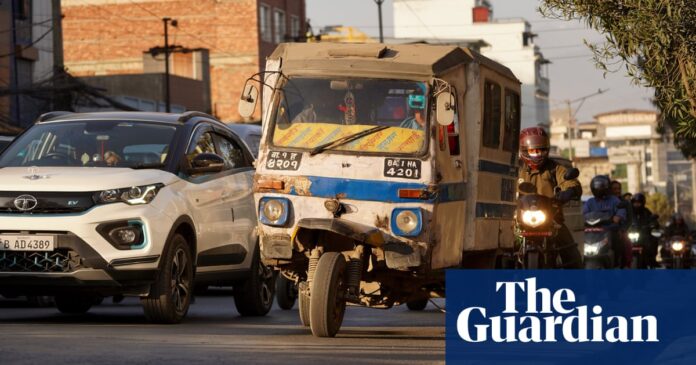In a rundown hangar in the heart of Kathmandu, the remains of a dozen electric trolley buses stand abandoned and corroding. Caked in dust and bird-droppings and lined with rubbish, they are a reminder of a bold experiment, launched 50 years ago, to electrify the city’s public transport system. Down the side of one is written, “Keep me alive”.
Today, that plea is being heard. More than 70% of four-wheeled passenger vehicles – largely cars and minibuses – imported into Nepal last year were electric, one of the highest rates in the world. The figure reflects a remarkable growth in the use of electric vehicles (EVs), which saw the country import more than 13,000 between July 2023 and 2024, up from about 250 in 2020-21.
Nepal’s government has set ambitious targets for wider take-up of EVs, with the aim that 90% of all private-vehicle sales and 60% of all four-wheeled public passenger vehicle sales will be electric by 2030.
The abandoned remains of electric trolley buses, which were first introduced to Kathmandu 50 years ago. Photograph: Pete Pattisson
The increasing popularity of EVs has raised hopes that they may help to reduce the chronic air pollution that has plagued Kathmandu for years. Nepal’s capital is regularly ranked among the world’s most polluted cities, with pollution from fine particulate matter often 10 to 20 times the World Health Organization’s guidelines.
Air pollution in Nepal is having a devastating effect on its population, accounting for nearly 19% of all deaths in 2021, according to analysis by the State of Global Air. If Nepal could reduce particulate pollution to the level recommended by the WHO, people living in Kathmandu could on average expect to live for 2.6 more years.
The Kathmandu valley is cloaked for much of the year in thick smog from brick kilns, road and construction dust, burning rubbish and crops, and emissions from the 1.75m vehicles – 0f which around 80% are two-wheelers – that clog the city’s streets.
The world’s highest mountain range overlooks the Kathmandu valley, where smog lowers residents’ life expectancy by 2.6 years. Photograph: Pete Pattisson
“Our analysis shows that transport contributes to about one-fourth of the fine particle matter air pollution in the valley,” says David Sislen, the World Bank’s country director for Nepal, Maldives and Sri Lanka. “Motorists switching to EVs is an important part of getting towards cleaner skies and improved health.”
The impact of the shift to EVs is even greater because almost all of Nepal’s electricity is clean, as it is generated by hydropower, and readily available, after the persistent power cuts that afflicted the country for decades were brought to an end in 2018.
I’m very excited. I don’t have to go to the petrol pump any moreKrishna Prasad Chaulagain, bus driver
The reasons for the popularity of EVs becomes clear at a showroom for the Chinese electric carmaker BYD, where Binaya Parajuli is about to pick up his new car.
“These days the best option is an EV. Petrol is expensive and the price fluctuates a lot. The price of electricity is stable and nowadays we have no shortage of it,” he says, before adding: “And I’m also making a small contribution to the environment.”
Parajuli says he is also attracted to the look of the car, reflecting a view that EVs are now a status symbol. “These cars are luxurious, even if our roads are not,” he says, as he cuts a cake to celebrate his new purchase.
Binaya Parajuli and his wife celebrate the purchase of their new electric vehicle. ‘These days the best option is an EV,’ he says. ‘Petrol is expensive.’ Photograph: Pete Pattisson
Cost savings are the main reason for the rise in interest in electric cars, says the sales manager, Loozah Maharjan. “Import taxes on EVs are lower than on petrol cars, running costs are a 10th of the price and banks offer generous finance deals for EVs,” he says.
skip past newsletter promotion
Sign up to Global Dispatch
Get a different world view with a roundup of the best news, features and pictures, curated by our global development team
Privacy Notice: Newsletters may contain info about charities, online ads, and content funded by outside parties. For more information see our Privacy Policy. We use Google reCaptcha to protect our website and the Google Privacy Policy and Terms of Service apply.
after newsletter promotion
And yet, the environmental and health benefits of the transition to EVs will remain limited until the most polluting vehicles – diesel buses and trucks – also become electric, says Bhushan Tuladhar, an environmental activist.
“There are three reasons this has not taken off,” he says. “One, the initial cost of purchasing electric buses; second, the lack of charging infrastructure; and third, the public transport system is chaotic.”
There are signs that this is changing. Tuladhar, in his role as a board member of Sajha Yatayat, a co-operative bus company, helped to import 40 electric buses from China, which now operate across the city. They run alongside hundreds of electric three-wheelers, which began to be introduced in the city in the 1990s.
Krishna Prasad Chaulagain charges his new minibus for the first time. He estimates the cost of charging his vehicle will be 15 times less than with petrol. Photograph: Pete Pattisson
Hundreds more electric minibuses now also ply routes out of Kathmandu, particularly on the narrow, twisting road through the mountains to the southern plains, which larger buses struggle to negotiate.
At a charging station on the edge of the Kathmandu valley, Krishna Prasad Chaulagain is charging his new minibus. “I’m very excited,” he says. “I don’t have to go to the petrol pump any more.”
Chaulagain estimates the price of charging his vehicle will be a 15th of the cost of petrol to cover the same distance. The time it takes to charge his minibus does not seem to bother him. “It means I get some rest,” he says.
Even if Nepal does manage to electrify its public transport system, Maheshwar Dhakal, head of the government’s climate-change management division, warns that more needs to be done. “The growth in EVs in Nepal is remarkable,” he says. “But if we become carbon neutral tomorrow, it doesn’t make sense at a global scale. The international community must follow our lead.”


